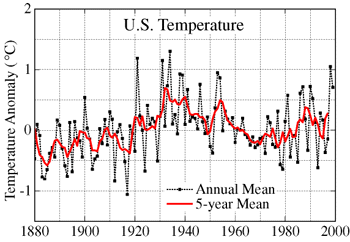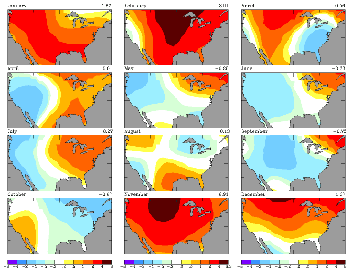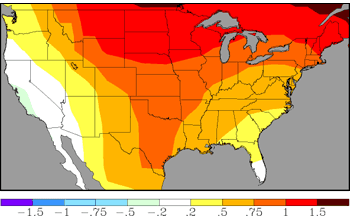| |
  |
 |
| |
|
January 28, 2000
Global surface temperatures in 1999 fell back from the record
setting high level of 1998, which was the warmest year in the period
of instrumental data, report researchers at the NASA Goddard Institute
for Space Studies who analyze data collected from several thousand
meteorological stations around the world. But 1999 was still one
of the warmest years of the century, as shown in Figure 1.
| |
|

Although global temperature fluctuates considerably from year
to year due to chaotic variability of the atmosphere and ocean,
there has been a long-term global warming trend underway since the
early 1960s, as illustrated in Figure 1. The 1999 data are consistent
with a continuation of that warming trend, with 1999 being
approximately the sixth warmest year in the record. The ranking of
years is approximate because of incomplete global coverage of
measurement stations and small errors in the measurements.
Most parts of the world were warmer than normal, i.e., warmer
than the 30-year period 1951-1980, as illustrated in Figure 2.
It was particularly warm across most of North America (except the
West Coast) and most of Eurasia. However, the tropical Pacific
Ocean was cool due to a strong La Niña. During a La Niña the
near equatorial region is cooled by upwelling of cool water from
the deep ocean.
|
|
Figure 1:
(a) Near-global annual-mean surface air temperature change,
based on meteorological station network, (b) global land-ocean
surface temperature index, which combines sea surface temperature
measurements for ocean areas with surface air temperature
measurements at meteorological stations.
(Click on any figure for a larger version.)
|

|
|
Figure 2:
Surface temperature anomaly for the 1999 calendar year derived
from measurements at several thousand meteorological stations
and satellite measurements of the ocean surface.
(Hansen et al., 1999; Reynolds and Smith, 1994)
|

The temperature in the United States was also warm, about
0.7°C above the 1951-1980 average (Figure 3). 1999 was
approximately the 10th warmest year of the century. The warmest
years in the United States occurred during the dust bowl era,
with 1934 being the warmest year.
Our analyzed temperature, in
the United States and the rest of the world, includes
corrections for urban effects on the record. Nearby rural
stations are used to adjust the long-term trends at urban
stations, as described by Hansen et al. (1999) (see references below).
The temperature anomalies fluctuate substantially from month
to month, as illustrated for the United States in Figure 4.
|
|
Figure 3:
Temperature anomaly (deviation from the 1951-80 average) for calendar
years for the contiguous United States.
|

|
|
Figure 4:
Monthly temperature anomalies (relative to 1951-80 average) in
the United States during 1999.
|

February and November were both exceptionally warm in the United
States. Averaged over the year, most of the United States was
warm in 1999 (Figure 5), except the West Coast and Florida.
These maps for the United States illustrate that even with
the level of warmth that occurred in the United States in 1999,
the local warming trend is less than natural year-to-year
fluctuations of monthly mean temperature. Thus for any given
location in the United States there are generally at least a few
months in the year that are cooler than normal. But the overall
tendency toward warming is enough that it is beginning to effect
the probability of a month or a season being warmer than normal.
In our discussion of 1998 temperatures (see below) we discussed
this concept that the climate "dice" are being "loaded" to a
degree that is beginning to be noticeable to people.
References:
1. Hansen, J., R. Ruedy, J. Glascoe, and M. Sato 1999.
GISS analysis of surface temperature change.
J. Geophys. Res. 104, 30997-31022.
2. Reynolds, R.W. and T.M. Smith 1994.
Improved global sea surface temperature analyses.
J. Climate 7, 929-948.
|
|
Figure 5:
Annual temperature anomaly (relative to 1951-80 average)
in the United States for 1999.
|

